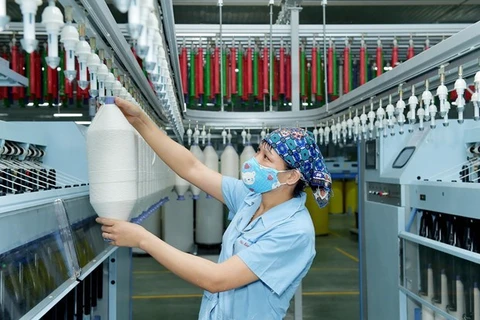 Processed industrial products continued to take the lead in export revenue in the first half of the year (Photo: VNA)
Processed industrial products continued to take the lead in export revenue in the first half of the year (Photo: VNA) Hanoi (VNA) – Domestic businesses showed positive signs of recovery, exports increased and supply chains resumed in the first months of this year, experts have said.
Notably, domestic firms’ export growth of over 20% has boosted production and business to help accelerate the restoration of supply chains, they added.
Garment-textile, footwear put best foot forward
The Ministry of Industry and Trade (MoIT) reported that processed industrial products continued to take the lead in export revenue in the first half of the year, with about 159.3 billion USD, up 17% year-on-year, making up 85.7% of the total export value.
Of the items, garments-textiles expanded 21.6% to 18.7 billion USD, and footwear rose 14.8% to 11.9 billion USD. The high growth rates come on the heels of the COVID-19 pandemic, according to Pham Tat Thang, a senior expert from the Vietnam Institute of Strategy and Policy for Industry and Trade under the Ministry of Industry and Trade.
Chairman of the Vietnam Textile & Apparel Association (VITAS) Vu Duc Giang attributed the impressive results of the garment-textile sector in the first six months to the benefits brought about by the free trade agreements (FTAs), to which Vietnam is a signatory.
The 15 FTAs have created an open, comprehensive market corridor for Vietnamese garment-textiles, while helping to broaden their market share globally, he continued.
A boost to growth
However, economists are still worried that political uncertainties in many countries will continue to adversely impact the global economy in the time ahead.
In Vietnam, the supply chain has also shown limitations as many garment-textile firms face a shortage of production materials. The shortage requires relevant policies to be consolidated to create momentum for the attraction of investments in materials, and business administration to be improved.
Cao Huu Hieu, General Director of the Vietnam Textile and Garment Group (Vinatex), said it is not easy to build a complete supply chain, suggesting the domestic garment-textile sector to perfect the first production steps and prepare its workforce in anticipation of higher production methods.
Vinatex has continuously provided updates on the supply of yarn, cotton and other materials for its member businesses. It is importing cotton in reserve for yarn enterprises to avoid any price risks, he said.
For the firms with free on board (FOB) shipping, Vinatex suggested them not to receive orders too early to ensure that order prices keep up with material prices.
Many footwear enterprises have also increased investments in materials, and set up joint ventures and cooperation with others to expand operation and ease their reliance on imports.
Thanks to such efforts, the rate of the localisation of materials in the sector has reached 55%, notably that of canvas shoes is 100% and sport shoes, 80%.
The MoIT said it is coordinating with other ministries and agencies to remove obstacles to businesses, and set out long-term solutions such as investing much in support industries, easing their dependence on imported materials, and raising their competitiveness in foreign markets.
The ministry has also stepped up the building and implementation of the textile-garment and footwear development strategies to 2030 with a vision towards 2050, and the programme on sustainable garment-textile and footwear development for 2021-2030.
At the same time, it has been focusing on personnel training and technological application in design and production, especially green technologies.
Regarding oil and gas, the MoIT and the Ministry of Finance has used the price stabilisation fund, and proposed the National Assembly adjust tax policies to help businesses ease market impacts and adapt to the new situation.
The MoIT will continue with measures to support enterprises, step up export promotion programmes, and promote and expand sales channels to fully tap the market./.























